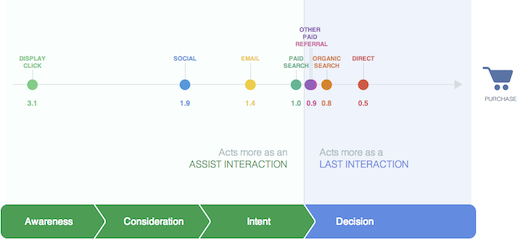Introducing “The Customer Journey to Online Purchase” — interactive insights on multi-channel marketing
Savvy marketers understand that you don’t always seal the deal with a single message, image, or advertisement. A user may see a display ad, click on a link from a friend, or do a search before buying something from your website — and all of these interactions can play a role in the final sale. It’s important to understand the entire customer journey so you can measure all of the elements that contribute to your campaigns, attribute the right value to them, and adjust your marketing budgets where appropriate.
That’s the philosophy behind Google Analytics tools like Multi-Channel Funnels and Attribution Modeling. Tens of thousands of our largest advertisers are gaining valuable insights from Multi-Channel Funnels every month, and we’ve collected these insights using aggregate statistics to develop a benchmarking tool — The Customer Journey to Online Purchase. This interactive tool lets you explore typical online buying behavior and see how different marketing interactions affect business success.

The tool draws on Ecommerce and Multi-Channel Funnels data from over 36,000 Google Analytics clients that authorized sharing, including millions of purchases across 11 industries in 7 countries. Purchase paths in this tool are each based on interactions with a single ecommerce advertiser.
You’ll find benchmark data for:
- how different marketing channels (such as display, search, email, and your own website) help move users towards purchases. For example, some marketing channels play an “assist” role during the earlier stages of the marketing funnel, whereas some play a “last interaction” role just before a sale.
- how long it takes for customers to make a purchase online (from the first time they interact with your marketing to the moment they actually buy something), and how the length of this journey affects average order values.
The data shows that every industry is different — the path to purchase for hotel rooms in Japan is not necessarily the same as the path as for an online supermarket in Canada.
A few findings stand out, in particular:
- As you might expect, customers typically click on display ads early in their purchase journeys, but in some industries, such as US travel and auto, display clicks tend to occur closer to the purchase decision.
- Across industries and countries, paid search has a fairly even assist-to-last interaction ratio, implying that this channel can act both in the earlier and later stages of the customer journey.

Advanced tip:
- Once you’ve explored the benchmarks, look deeper into your own marketing data with the Multi-Channel Funnel reports, and consider defining your channels and campaigns to separate out categories that are specific to your business needs.
We also see interesting patterns emerge when examining the length of the customer journey. While the majority of purchases take place within a single day or a single step (i.e., a single interaction with one marketing channel), longer paths tend to correlate with higher average order values.
For example,
- in US Tech, online purchases that take more than 28 days are worth about 3.5 times more than purchases that occur immediately. And while 61% of tech purchases take place on that first day, only 53% of revenue comes from single-day purchases.
- in Consumer Packaged Goods (CPG), on the other hand, most purchases (82%) are quick, likely because these are smaller and simpler purchases that don’t require much research.
- in Edu / Gov, 41% of revenue comes from multi-day purchases, but 60% of revenue comes from multi-step purchases — suggesting that even when customers make decisions in a relatively short time period, they often have multiple marketing interactions before purchasing.

Advanced tip:
- In Multi-Channel Funnels or the Attribution Modeling Tool, you can adjust the lookback window to reflect the typical length of the purchase path in your industry. For example, if your business tends to have shorter paths, you can zoom in on paths that take 5 days or less:

Putting the benchmarks to work
For marketers, it’s always a crucial challenge to design campaigns that deliver the right message at the right moment in a customer’s journey to purchase. We hope these benchmarks will provide useful insights about the journey and help you put your business into context. In particular, take a look at the final infographic, the “Benchmarks Dashboard,” to get a quick overview of your industry. Then, when you view your own data in the Multi-Channel Funnels reports in Google Analytics, you’ll gain a better understanding of where different channels impact your conversions and what your typical path looks like, so you can adjust your budgeting and marketing programs accordingly.
Try The Customer Journey to Online Purchase today on Google’s new Think Insights website.


Write a Comment